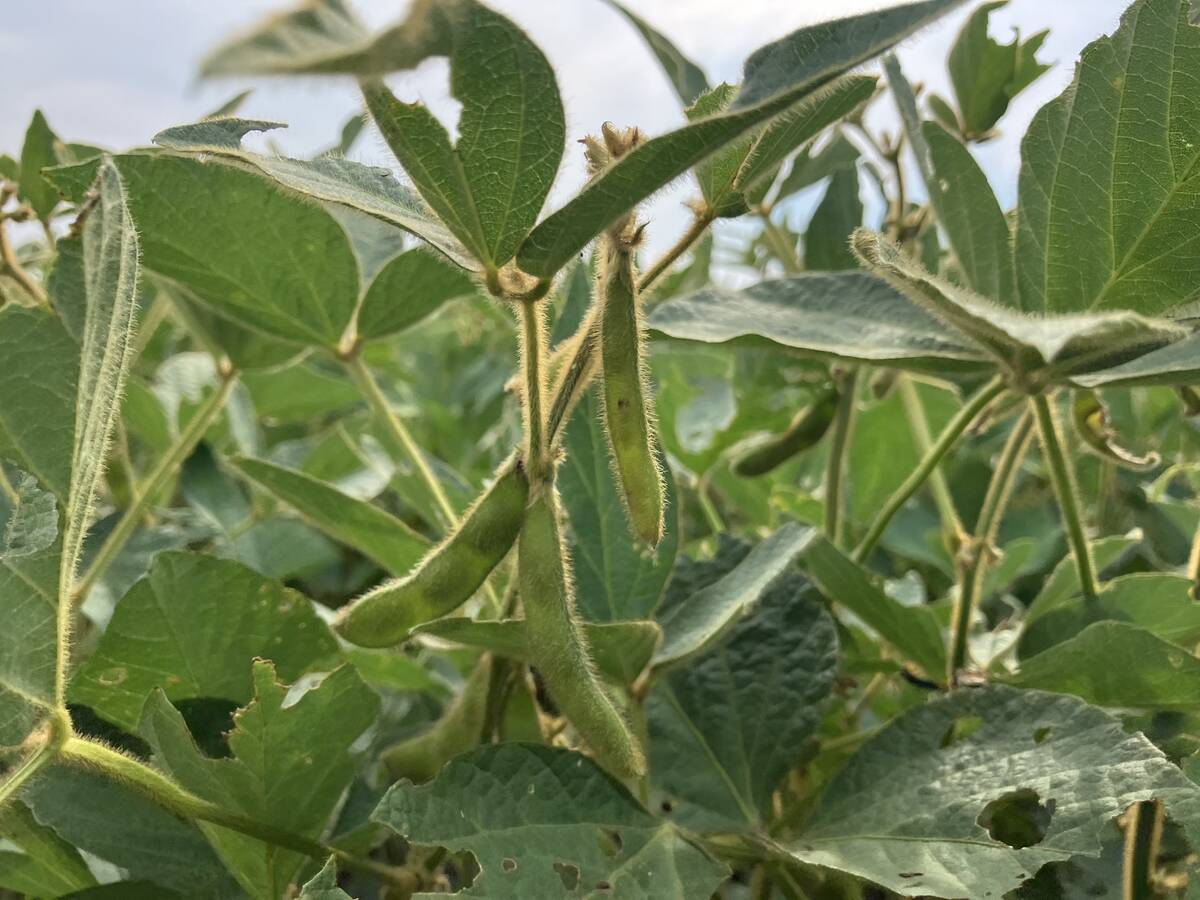Proper temperature key to success | Little research has been done, but anecdotal evidence indicates bags can be effective
Bernie Schloorlemmer spent a few days earlier this month hauling high moisture canola out of a grain bag to the local elevator to be dried.
Poor harvest weather this fall forced hundreds of farmers in Alberta’s Peace River region to harvest tough grain and then cross their fingers that they could dry it before it started to heat.
All of Schloorlemmer’s canola and wheat came off the field tough.
“It was 18.7 (percent) moisture canola coming out of a grain bag and it was fine,” said Schloorlemmer, who farms near Rycroft, Alta.
Read Also

Soybean market still figuring out implications of China-U.S. pact
Soybean futures had a muted reaction to the U.S. trade deal with China as the market tries to figure out the nuances of the deal.
He has stored grain in bags for the past seven years.
“The bottom line is if it’s tough we put it in a bag; if it’s dry we put it in a bin,” said Schloorlemmer.
“We have a big farm and we don’t even own a dryer, we have such confidence in putting tough grain in bags.”
Schloorlemmer estimates 25 to 30 farmers in his area of the central Peace bought grain-bagging equipment this fall as a way to handle tough grain.
“When it’s 24 above and beginning of September, we’re patient and don’t take canola off,” he said.
“When we get into the middle or the end of October, we get panicky and take it off and stuff it into the bags.”
The keys to ensuring safe storage are making sure the outside temperature is cool and sealing the bags quickly. Schloorlemmer said the temperature of the bag will often increase one or two degrees when he is monitoring the canola and then drop back down and stabilize.
“I have more confidence monitoring grain in a bag than a bin.”
Schloorlemmer’s experience has given him the confidence to put hundreds of thousands of dollars of high priced crop in long plastic bags at the edge of his fields, but there is little research that agrologists and grain bag salespeople can use to assure other farmers that bags are a safe storage system.
Allan Gifford of Foster’s Seed and Feed in Beaverlodge, Alta., who sells bagging equipment to farmers, said he is careful when recommending maximum moisture levels for storing grain in bags.
“We are very cautious,” he said.
“Canola is worth a lot of money. We’ve seen too many losses in bins for us to recommend pushing the limits very far.”
Gifford has been hesitant to use grain bags on his own farm and didn’t store canola in grain bags this year.
“We’re retailing them and selling the machines, but we don’t want people to have problems,” he said.
“We want things to work. We want to err on the side of caution. We don’t recommend pushing the limits on what we’re certain will work.”
Aaron Yeager of Grain Bags Canada said he hasn’t seen long-term research on storing canola in grain bags, but he knows what works on his east-central Saskatchewan farm.
“Putting canola in a bag is not an issue,” said Yeager, who farms near Lake Lenore, Sask.
“On our farm, we put just about 100 percent of our canola in a bag. It’s a safer place to put canola.”
However, there are caveats. He doesn’t recommend dumping high moisture canola into a bag and forgetting about it for the winter.
“If you got stuff that’s 20 (percent moisture), for peace of mind I would probably dry it pretty quickly as soon as harvest is over,” said Yeager.
“I’m comfortable with 12 or 13 and wouldn’t lose any sleep over it.”
He said he would feel safe leaving 12 or 13 percent moisture canola in a bag until February or March before drying it.
“The window for canola for moisture is a lot bigger than what people think.”
Yeager also recommended checking grain that was harvested on a hot day.
The bag’s long, narrow design allows canola to cool more quickly than when in a bin, especially with cool, prairie weather.
“The bags let the heat pass through.”
The biggest tricks are knowing the condition of the grain and the temperature of the day when the grain went in the bag and ensuring that the bag is properly sealed.
Brad Hanmer of Govan, Sask., said he has lots of canola in grain bags, especially crop that was harvested in hot weather.
“We will put our out-of-condition canola in a grain bag on purpose,” he said.
The worst place for hot canola is a tall, narrow wooden grain elevator where the heat rises.
“In our experience, grain bags are a great way to manage hot canola.”
However, bagged canola must still be managed, especially with wildlife and the occasional heated spot in the bag.
“As quick as we can, we pick it up. You’ve got to manage it properly,” said Hanmer.
“Bags aren’t perfect. With anything, you’ve got to use common sense.”
Kim Stonehouse, a regional crop specialist with Saskatchewan Agriculture, said a late, wet harvest in 2009 gave the department an opportunity to learn more about storing higher moisture canola in grain bags.
Eighty percent of the canola in northeastern Saskatchewan was still in the field at the beginning of November of that year. Farmers were looking at storing their canola in grain bags in an effort to buy time until it could be dried.
“The farmers wanted to know how long they could keep canola without heating,” said Stonehouse.
“We didn’t have much information on even storing it in a bin because all of our information was based on 2,000 bushels or smaller. Everybody is storing things in 5,000 bu. or bigger. We were saying a couple days at most and that was just an estimate based on what they did know and we had absolutely no data on bags.”
Stonehouse said canola in bags did pretty well that year. Temperatures were below 10 C as the canola was combined and the bags filled, so the crop cooled off quickly. Some of it lasted in the bag until it was taken out in the spring. However, some canola began to get warm after almost a month.
“Getting 26 to 28 days storage was pretty good. Farmers were pretty happy with that. It was probably better than being able to put it in a bin.”
By probing the bags every six metres to take temperature readings, provincial officials learned that the moisture content of the grain was not even. The temperature started to rise in spots in a couple of bags and the farmers quickly emptied them.
“You need to monitor them very closely,” Stonehouse said.
“That’s my biggest caution, is you have to keep your eye on it. When they start to go bad, they go bad really quick. I don’t recommend people putting canola in a bag unless there is no other option, and in this case there wasn’t another option.”
Canola agrologist Doug Moisey reminded farmers during an Alberta Canola Producers Commission meeting in Camrose that they need to monitor their grain bins for heating.
“Go home and check some bins,” he said.
A University of Manitoba research project has discovered after one year of a two year study that it’s safe to store dry canola in grain bags for up to a year without spoiling.
“If you store the canola at a moisture content of one to two points below dry and it is stored on a well drained area and no protrusion of the bag, it should be able to store grain for up to a year,” said Digvir Jayas, a professor of biosystems engineering at the U of M.
Jayas’s project, which was funded by the Canola Council of Canada, compared canola stored at three, eight, 10 and 14 percent moisture. The bags were filled at the beginning of October 2010 and kept for 10 months.
As expected, the eight and 10 percent moisture did not spoil and there was no impact on seed quality. The 14 percent moisture canola was spoiled and mouldy, said Jayas.
“We would be shocked if the 14 percent moisture did not spoil,” he said.
“As the moisture content gets higher and higher, the chances of spoilage would increase.”
Twelve percent moisture will replace 14 percent moisture canola in the second year of research.
“My personal feeling is even 12 percent would spoil. People, in my view, should not be using it for long-term storage,” said Jayas.
Jim Bessel, an agronomist with the Canola Council of Canada, said it’s that discrepancy between research findings and anecdotal evidence from farmers that the council is trying to address.
“We hear these testimonials, but we need some good hard science to verify, not only the length of storage for canola, but the quality factor,” said Bessel.
“We just don’t know.”
Yeager said most farmers wouldn’t leave tough canola in a bag until July. He speculated that the canola in the research study started to spoil when the air temperature increased during the spring.
Bessel said leaving canola in the bag for 10 months gives researchers information on when it’s best to take it out.
“That was the original thought behind all this research, is once the project is complete, at least we have some data to work from and some modelling to help us understand what is happening or not happening.”
Jayas said he found hot spots in one of the 14 percent canola bags in the second week of storage.
“All 14 percent bags were five to 10 C warmer than eight and 10 percent bags, even in peak winter.”















